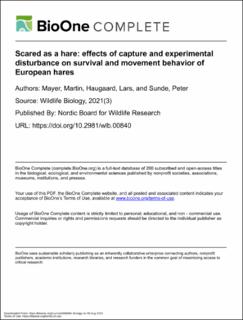Scared as a hare: Effects of capture and experimental disturbance on survival and movement behavior of European hares
Peer reviewed, Journal article
Published version
Permanent lenke
https://hdl.handle.net/11250/3119422Utgivelsesdato
2021Metadata
Vis full innførselSamlinger
Sammendrag
Capture and handling of wildlife is an important component of wildlife studies, and hunting can be a central tool for wildlife management. However, human-caused disturbance of animals can cause various negative effects on individuals. Thus, an increased understanding of different disturbances on animals will allow improved mitigation of human stressors for wildlife, and provides the basis for data-censoring when using information obtained from captured individuals. Here, we investigated the effects of capture and handling, as well as experimental disturbance, on the movement behavior of GPS collared European hares Lepus europaeus. Of 28 hares captured in box traps, three died during handling to fit GPS collars,
likely due to acute stress. Apart from an 11% decrease in activity in both sexes the first four days after capture compared to later, capture events had no significant effects on subsequent movement behavior. Hares that were disturbed experimentally, i.e. flushed with or without a shotgun shot fired, moved on average (± SD) 422 ± 206 m directly subsequent to the disturbance, leading to a spatial displacement of their short-term home range and an increased daily home range size on the disturbance day. Home range sizes returned to their before disturbance size on the following days, but hares remained further from field edges and spent more time in short vegetation in the days after simulated hunting, though this effect was comparatively small. Overall, our findings indicate that hares only marginally changed their movement behavior in response to short-term disturbances. Therefore, capture and hunting disturbance should not have severe negative effects on the movement behavior of individuals, but future studies should aim to reduce acute capture-related stress to avoid mortalities. We recommend that researchers should censor the first four days after capture from their analyses to avoid using potentially biased data.

